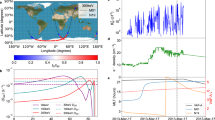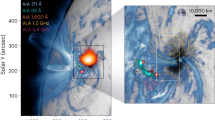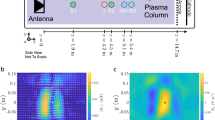Abstract
THE fact that large cosmic ray air showers can generate detectable pulses of electromagnetic radiation at radio frequencies was first established by Jelley and his collaborators at Harwell, Jodrell Bank and Dublin1,2. The pulses have been detected by several other research groups3–5, but there is as yet no clear picture of just how the radiation is produced. Theoretical treatments by Kahn and Lerche6, Colgate (personal communication) and Allan7, all suggest that the principal mechanism should be the motion of charge due to the lateral displacement of shower particles by the Earth's magnetic field. The polarization to be expected from this geomagnetic mechanism is perpendicular both to the shower axis and to the magnetic field lines.
This is a preview of subscription content, access via your institution
Access options
Subscribe to this journal
Receive 51 print issues and online access
$199.00 per year
only $3.90 per issue
Buy this article
- Purchase on Springer Link
- Instant access to full article PDF
Prices may be subject to local taxes which are calculated during checkout
Similar content being viewed by others
References
Jelley, J. V., Fruin, J. H., Porter, N. A., Weekes, T. C., Smith, F. G., and Porter, R. A., Nature, 205, 327 (1965).
Jelley, J. V., Charman, W. N., Fruin, J. H., Smith, F. G., Porter, R. A., Porter, N. A., Weekes, T. C., and McBreen, B., Nuovo Cimento, 46, 649 (1966).
Allan, H. R., and Jones, J. K., Nature, 212, 129 (1966).
Barker, P. R., Hazen, W. E., and Hendel, A. Z., Phys. Rev. Lett., 18, 51 (1967).
Borzhkovskii, I. A., Volovik, V. D., Kobizskoi, V. I., and Shmatko, E. I., JETP Letters, 3, 186 (trans 118) (1966).
Kahn, F. D., and Lerche, I., Proc. Roy. Soc., A, 289, 206 (1966).
Allan, H. R., J. Atmos. Terr. Phys. (in the press).
Askaryan, G. A., J. Exp. Theoret. Phys., 14, 441 (1962).
Rozental, I. L., and Filichenkov, M. L., Izv. Akad. Nauk. SSSR ser fiz., 30, 1703 (1966).
Porter, R. A., Smith, F. G., and Torbitt, W. S., Nature, 213, 1107 (1967).
Vernov, S. N., Abrosimov, A. T., Volovik, V. D., Zalyubovskii, I. I., and Khristiansen, G. B., JETP Letters, 5, 157 (trans 126) (1967).
Author information
Authors and Affiliations
Rights and permissions
About this article
Cite this article
ALLAN, H., NEAT, K. & JONES, J. Mechanism of Radio Emission from Extensive Air Showers. Nature 215, 267–268 (1967). https://doi.org/10.1038/215267a0
Received:
Issue Date:
DOI: https://doi.org/10.1038/215267a0
This article is cited by
-
Radio Pulses from the Direction of the Galactic Centre
Nature (1973)
-
Radio Pulse Production in Extensive Air Showers
Nature (1969)
Comments
By submitting a comment you agree to abide by our Terms and Community Guidelines. If you find something abusive or that does not comply with our terms or guidelines please flag it as inappropriate.



